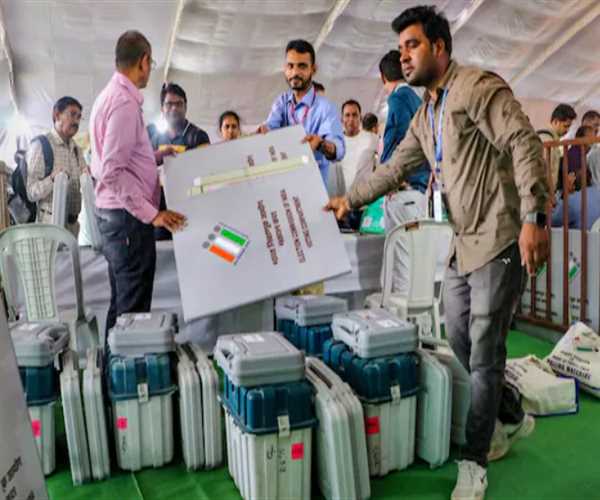
16-May-2024 , Updated on 5/16/2024 5:09:28 AM
Lok Sabha election 2024: How much does it cost?
Conducting an election of this magnitude is a massive effort for the Election Commission (EC), necessitating rigorous planning to guarantee that the voting rights of the country's large population are protected. This election will see roughly 968 million eligible voters exercising their political rights.
As the EC so well puts it, this is a festival of democracy, representing the world's greatest electoral movement in terms of both personnel and resources.
However, organizing an election on such a large scale comes with a high expense. The costs associated with holding a Lok Sabha election have progressively increased over the years.
For example, during India's first election in 1951-52, which lasted 68 stages, the cost was a mere Rs 10.5 crore. By 2019, the expenditure has risen to a whopping Rs 50,000 crore ($7 billion), according to a Centre for Media Studies research.
Based on prior years' trends, the 2024 election is likely to cost about double the amount of the previous election, totaling a whopping Rs 1,00,000 crore.
This increase in expenditures may be ascribed to a variety of causes, including an increase in the number of eligible voters and changing campaign techniques, including increased spending on social media. The Lok Sabha election cost Rs 3,870 crore in 2014, representing a huge rise over previous years.
Analyzing the spending per elector reveals that the cost has risen from 6 paise in 1951 to Rs 46 in 2014. This demonstrates the increasing cost burden of organizing elections in India.
N Bhaskara Rao, chairman of the Centre for Media Studies, told Bloomberg that social media campaigning accounts for a significant amount of election spending.
This opinion was shared by Simon Chauchard, a Columbia University lecturer, who observed that Indian politicians are increasingly using expensive and inventive tactics to attract voters.
"Indian politicians believe you must do new, crazier, larger, and louder things. "It's a bunch of panicky candidates throwing money around to voters and vendors selling all kinds of things useful in a political campaign," he added.
But what precisely does the Election Commission spend during polling?
The costs are various, ranging from deploying officials and armed guards to erecting polling booths, purchasing electronic voting machines (EVMs), collecting other essential equipment such as edible ink, and conducting awareness campaigns.
Purchasing EVMs accounts for a large amount of the expenditures. According to an Indian Express article, since the 2019 Lok Sabha elections, the cost of acquiring and maintaining EVMs has risen.
The Centre set out Rs 25 crore for EVMs in its first budget following the election. In the most recent Budget, Rs 1,891.8 crore was initially allotted for EVMs, with an extra demand for grants of Rs 611.27 crore presented by Union Finance Minister Nirmala Sitharaman during the Winter Session of the House.
Administrative expenditures account for a significant portion of the total expenditure. The EC must compensate its officials and volunteers for their poll-related efforts. Officials are compensated to attend training sessions and travel. The EC also conducts and videographs polls and political party campaigns, which greatly increases expenditures.
A new EC ruling, dated March 22, indicates that a presiding officer gets paid Rs 350 per day, while polling officers are paid Rs 250 per day.
According to government data, the EC's budget grew from Rs 236.6 crore in 2018-2019 to Rs 340 crore in 2023-2024. This growth corresponds to an increase of EC workers, from 591 in 2022 to 855 in 2024.
Given the scope of the Lok Sabha polls, experts predict the cost of elections to rise further. The first general election had 1,874 candidates from 53 parties compete in 401 constituencies (including dual member seats), needing 196,000 voting stations.
In 2019, these statistics skyrocketed, with 8,054 candidates from 673 parties competing in 543 seats, requiring 1.037 million voting booths.
And who pays the full cost?
According to recommendations given by the Ministry of Law and Order in October 1979, the Centre will completely fund the Lok Sabha election.
Similarly, the state government bears all of the costs associated with state Assembly elections. If state and Lok Sabha elections are held simultaneously, the prices break up flippantly among the states and the Centre.
This time, together with the Lok Sabha elections, the states of Andhra Pradesh, Sikkim, Arunachal Pradesh, and Odisha will vote on May 13th.
Why is the 2024 Lok Sabha election the most expensive in records?
Given the period of the election, it's projected to be pretty luxurious. The 2024 Lok Sabha elections could be held in seven components, lasting forty four days. The first segment starts today, April 19, with succeeding levels on April 26, May 7, May 13, May 20, May 25, and June 1, for that reason. The results might be released on June 4th.
This time, the electoral process will be closed for 82 days, starting with the Election Commission's statement of polls on Saturday and finishing with vote counting.
The forty four-day election season in 2024 will be the longest since the first Lok Sabha election in 1951–1952. The previous polls, which ran from October 25, 1951 to February 21, 1952, were conducted in 68 sessions, with an unprecedented 105 million people using their newly gained voting rights.

CONTENT WRITER
Writing is my thing. I enjoy crafting blog posts, articles, and marketing materials that connect with readers. I want to entertain and leave a mark with every piece I create. Teaching English complements my writing work. It helps me understand language better and reach diverse audiences. I love empowering others to communicate confidently.
Join Our Newsletter
Subscribe to our newsletter to receive emails about new views posts, releases and updates.
Copyright 2010 - 2025 MindStick Software Pvt. Ltd. All Rights Reserved Privacy Policy | Terms & Conditions | Cookie Policy